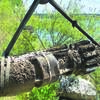

Canyon Lake Water Supply Company (CLWSC), which currently provides the city of Blanco with the majority of its water supply, confirmed that zebra mussels have reduced water production at its water treatment plants and is asking residents north of the lake to reduce water use by limiting landscape irrigation.
“Customers should continue water usage for indoor use only until further notice,” Larry Jackson, Canyon Lake Water Supply Company customer service manager said. “We are running the Canyon Lake Shores treatment plant at partial capacity to maintain water storage levels.”
“We are still assessing our next steps to inspect and clean the remaining pumps and intake pipes. Additionally, we’ve had some main line breaks in the impacted service areas which have hampered our efforts. As long as customers continue to restrict usage to indoor usage only, that will go a long way to preventing a low pressure or no water situation.”
The proliferation of zebra mussels in the lake has not affected water quality.
“Water quality has not been impacted,” he said. “The function of our water treatment plants is to disinfect and filter the water to prevent any organisms, like the zebra mussel, from entering the public drinking water supply.”
Jackson confirmed the existence of zebra mussels was confirmed during Summer 2017 in the Canyon Lake Reservoir, becoming yet another lake in Texas impacted by the extremely evasive animal. They reproduce quickly and usually have harmful economic, environmental and recreational impacts on reservoirs and rivers.
The city of Austin has struggled with managing water supply and quality due to the invasive species earlier this year.
“When they were discovered in 2017, CLWSC began a regular program to inspect and clean (if needed) our water treatment plant intake pipe screens,” Jackson said. “We have three water treatment plants on Canyon Lake, and we would perform this inspection every six months. Teams of divers and specialists are cleaning the intake pipes. Once complete, the recently cleaned pump will be put back into the intake pipe and put back into service.”
Currently, the Canyon Lake treatment plant is partially back online.
“Until we can assess, inspect, clean and restore all pumps and intake pipes, the treatment plant will not be at full production,” he said. “We anticipate that we will be back at full production sometime early this week.”
While repair work is occurring, all CLWSC customers on the north side of Canyon Lake, including Blanco as well as Spring Branch and Bulverde areas, limit their water usage to essential indoor use only.
“Knowing that 60 to 70 percent of summer water consumption is for landscape irrigation, CLWSC will still have ample water supply as long as customers work in partnership to reduce their usage during this time,” Jackson said. “At the same time, CLWSC is working on short-term and long –term solutions to manage this issue going forward.”



